Exploring the Intersection of Neurodevelopmental Disorders
Autism spectrum disorder (ASD) and dyscalculia are complex neurodevelopmental conditions that often co-occur, creating unique challenges in learning and daily functioning. This article explores their connection, highlighting how these disorders interact, affect cognitive abilities, and what therapeutic strategies show promise for those affected.
Defining Autism Spectrum Disorder and Dyscalculia
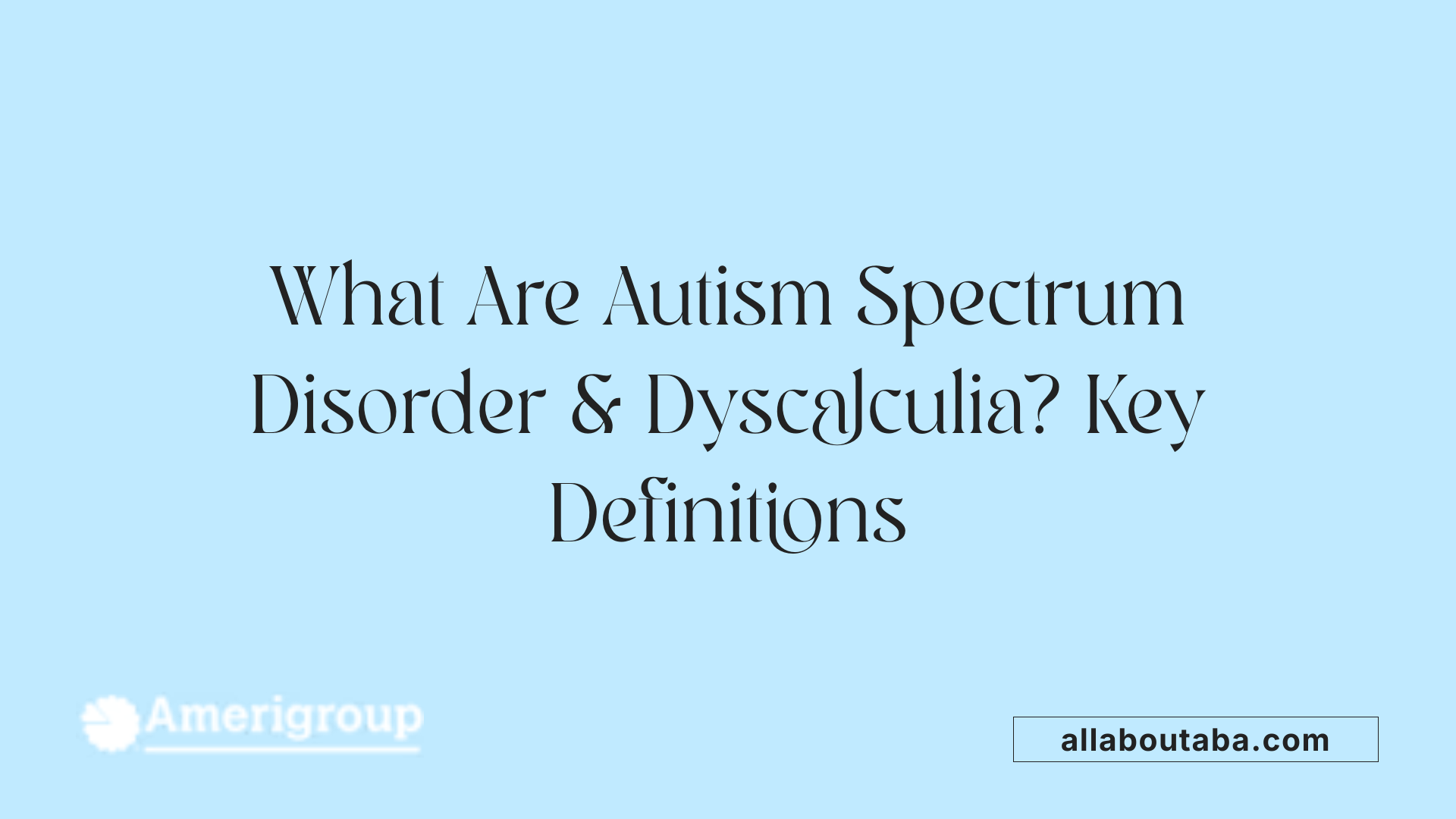
What are autism spectrum disorder and dyscalculia?
Autism spectrum disorder (ASD) is a neurodevelopmental condition that affects how people communicate, learn, and behave. It influences verbal skills, social interaction, executive functions like planning and organization, and sensory processing. ASD can result in challenges with joint attention, interpreting social cues, and language development.
Dyscalculia is a specific learning disability focused on difficulties with math and numbers. Individuals with dyscalculia struggle with counting, recognizing numbers and patterns, performing mental arithmetic, telling time, and recalling directions. This condition typically appears in childhood and makes understanding numerical information harder.
How often do ASD and dyscalculia occur together?
Children with autism are more prone to having additional learning difficulties, including dyscalculia. Research indicates a significant overlap between the two, with many autistic children also showing signs of math-related learning challenges. This co-occurrence impacts their academic progress, especially in mathematics problem solving and basic calculation skills.
Understanding their co-existence is important because both ASD and dyscalculia affect cognitive skills like attention, information processing, and executive functioning. Addressing them together can lead to better support and intervention strategies that improve learning and daily functioning for these individuals.
How Autism Influences Mathematical Abilities
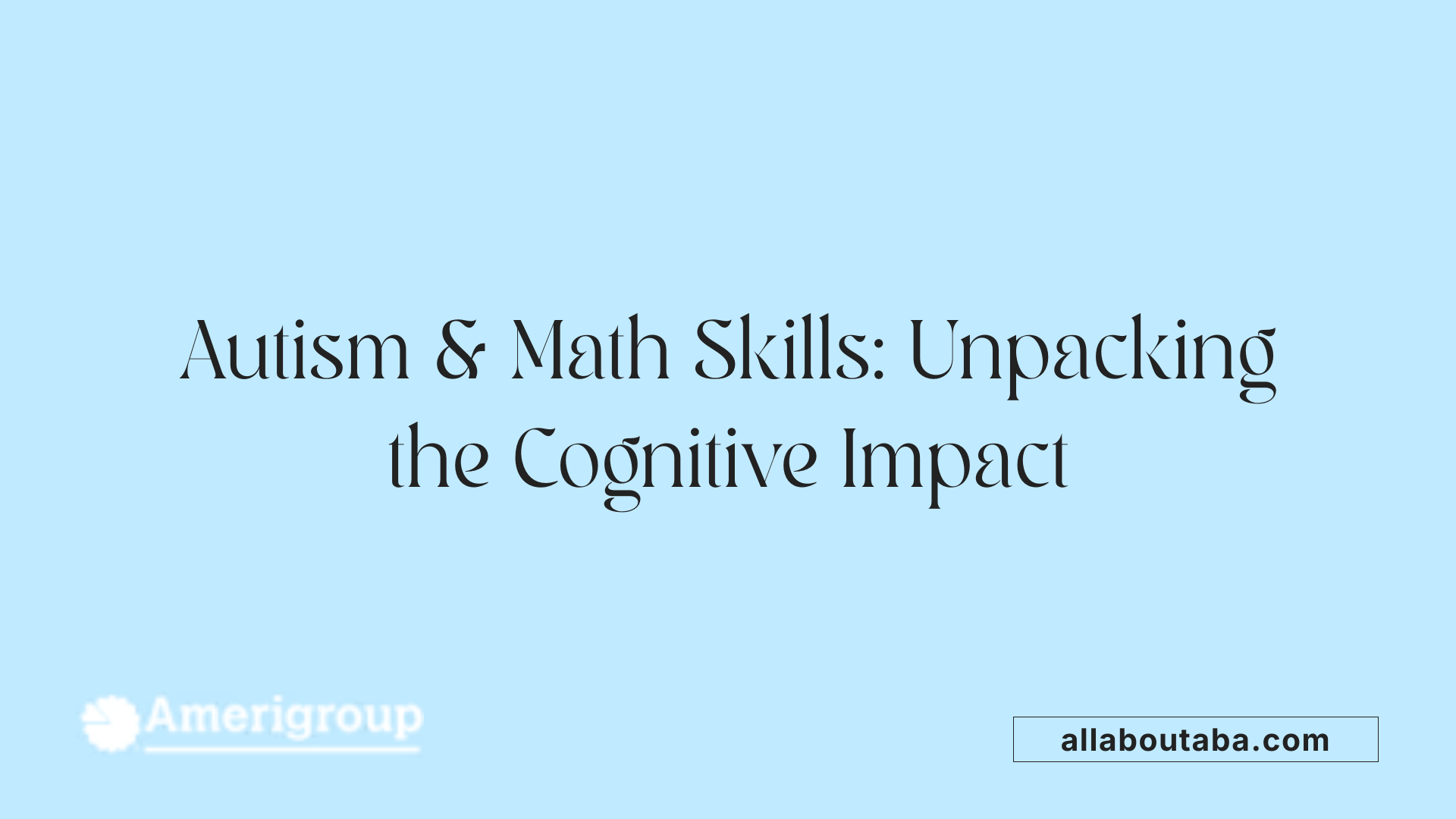
How does autism affect mathematical skills?
Autism Spectrum Disorder (ASD) can significantly impact a person’s ability to perform mathematical tasks. Research consistently shows that individuals with autism often face challenges in basic math skills such as addition and subtraction, as well as in more complex problem-solving tasks. Difficulties in these areas can stem from underlying differences in cognitive processing, especially in executive functioning and information processing.
Role of perceptual reasoning and verbal ability
Among the cognitive skills influencing math performance in autistic individuals, perceptual reasoning stands out as a strong predictor. This involves nonverbal concept formation, visual perception, and fluid reasoning, all of which contribute substantially to how well someone with ASD can solve math problems. Verbal ability also plays an important role; higher verbal IQ is linked with better mathematical problem-solving skills. These two factors together help explain much of the variability seen in math abilities among autistic people.
Variability in math skills among autistic individuals
It's important to recognize that mathematical abilities within the autism community are not uniform. While around 22% of autistic children exhibit significant difficulties in math problem solving, a small minority—approximately 4%—demonstrate mathematical giftedness. This wide range of abilities indicates considerable heterogeneity, where some individuals may excel in math, but many others may require targeted support to overcome learning difficulties.
Understanding these nuances is vital for developing effective educational and therapeutic approaches tailored to each person’s strengths and challenges. For example, targeting perceptual reasoning skills and enhancing verbal communication could help improve math outcomes for many autistic learners.
The Overlap Between Autism and Dyscalculia: Cognitive and Sensory Factors
What cognitive and sensory factors connect autism and dyscalculia?
Autism and dyscalculia share several interconnected cognitive and sensory challenges that affect learning, especially in math-related tasks. Both conditions commonly involve difficulties with executive functions, including planning, organization, working memory, and sustained attention. These deficits can hinder an individual's ability to manage complex mathematical problem-solving and daily tasks requiring number processing.
Sensory processing difficulties, prevalent in many autistic individuals, further complicate math learning. Heightened sensitivities to sensory input may disrupt concentration and lead to avoidance behaviors, making it harder to engage with numerical concepts. This sensory barrier can increase the challenges already posed by dyscalculia.
Research highlights that these overlapping difficulties create compounded barriers for children and adults with autism when they experience dyscalculia. Addressing both cognitive and sensory issues is essential for effective support and intervention.
Shared cognitive difficulties
- Working memory struggles limit the ability to hold numbers and operations in mind.
- Attention deficits cause challenges in focusing on step-by-step math procedures.
- Impairments in processing speed slow down understanding and response time.
Executive function deficits
- Planning and organization issues interfere with sequencing math problems.
- Poor self-regulation leads to frustration and avoidance of math tasks.
Sensory processing challenges
- Over-responsiveness or under-responsiveness to sensory stimuli can distract from learning.
- Sensory overload in classroom environments can disrupt concentration on numerical tasks.
Combining support for both executive functioning and sensory processing through tailored therapies and classroom accommodations offers the best outcomes for individuals facing these dual challenges.
Co-occurring Conditions: ADHD, Dyscalculia, and Autism
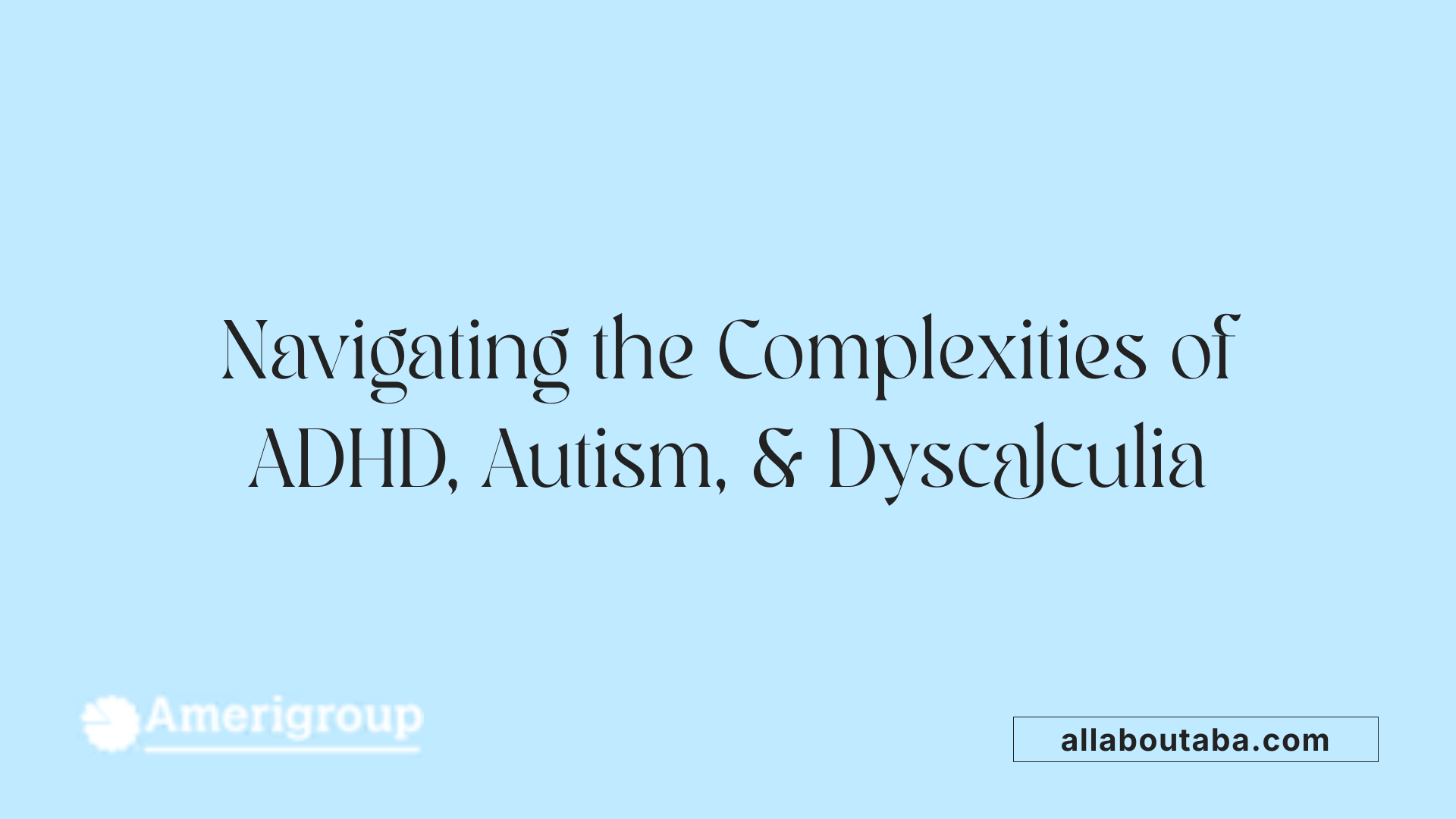
How do ADHD, autism, and dyscalculia together affect learning?
When ADHD co-occurs with autism and dyscalculia, the combined challenges significantly affect learning capabilities, especially in mathematics. ADHD contributes difficulties with attention and self-control, which further disrupt working memory and executive functioning already impacted by autism and dyscalculia. This overlap leads to compounded barriers in tasks requiring focus, organization, and processing speed, complicating math learning and problem solving.
Impact of ADHD on learning
ADHD affects a child’s ability to maintain attention and manage impulses, which can interrupt their engagement with educational tasks. With co-occurring autism and dyscalculia, these attentional difficulties exacerbate challenges in understanding number concepts, recognizing patterns, and applying math skills. Children might struggle to follow multi-step instructions, keep track of calculations, or remain focused during math activities.
Compounded difficulties
The co-existence of these conditions multiplies the learning obstacles. Autism’s sensory processing challenges, combined with ADHD-related distractibility and dyscalculia’s specific math learning disabilities, create a complex profile that needs targeted supports. For instance, difficulty with executive functioning like planning and organization is intensified, making standard learning approaches often ineffective without modification.
Executive functioning and attention issues
Executive functions—including working memory, flexible thinking, and self-regulation—are critical for mathematical reasoning. ADHD impairs these functions, increasing processing challenges. This implies that learners with all three conditions require comprehensive assessment that considers cognitive, sensory, and educational factors to tailor interventions. Multisensory learning, structured instruction, and visual supports can help mitigate these challenges.
Individualized and sustained support plans that involve input from educational psychologists, occupational therapists, and teachers are essential. These plans emphasize building functional math skills, boosting confidence, and enhancing independence despite the complex interplay of attention, sensory, and learning difficulties.
Educational and Therapeutic Interventions for Autism and Dyscalculia
What therapeutic approaches help individuals with autism and dyscalculia?
Early intervention is crucial for children with autism and dyscalculia. Applied Behavior Analysis (ABA) is a widely used therapy for autistic children, focusing on improving communication, social skills, and learning through structured and positive reinforcement techniques. For dyscalculia, coordinated efforts involving parents and teachers help tailor learning strategies to the child's needs.
Cognitive Behavioral Therapy (CBT) is effective for adolescents and adults with autism and dyscalculia. It helps build executive functioning skills such as planning and organization, alongside emotional regulation to manage anxiety, frustration, and improve self-esteem.
Educational environments benefit from multisensory learning approaches that engage visual, auditory, and tactile methods. Structured instruction and environmental accommodations — like clear routines and reduced sensory distractions — support children’s focus and comprehension.
Combining these therapies and supports creates an integrated framework that addresses both cognitive challenges and emotional well-being, helping individuals develop functional math skills and confidence.
Importance of Early Intervention
Starting therapies early maximizes developmental gains and academic success. Children with autism frequently face overlapping challenges with dyscalculia, making early identification and targeted support essential for improving mathematical abilities and reducing long-term difficulties.
Applied Behavior Analysis (ABA)
ABA uses data-driven techniques to teach concrete skills, including problem-solving and social communication. It adapts well to the varied learning profiles of autistic children and can be tailored to address dyscalculia-related math difficulties.
Cognitive Behavioral Therapy (CBT)
CBT helps adults and older youths manage test anxiety and build coping strategies for executive dysfunctions. It is effective in addressing emotional barriers to math achievement often seen in autism and dyscalculia.
Multisensory Learning and Accommodations
Using multiple senses in instruction—such as manipulatives for counting, visual aids for pattern recognition, and rhythm or movement to understand time—enhances engagement and retention. Accommodations like extra time and quiet testing spaces help reduce anxiety and sensory overload.
Mental Health Risks and Support Needs
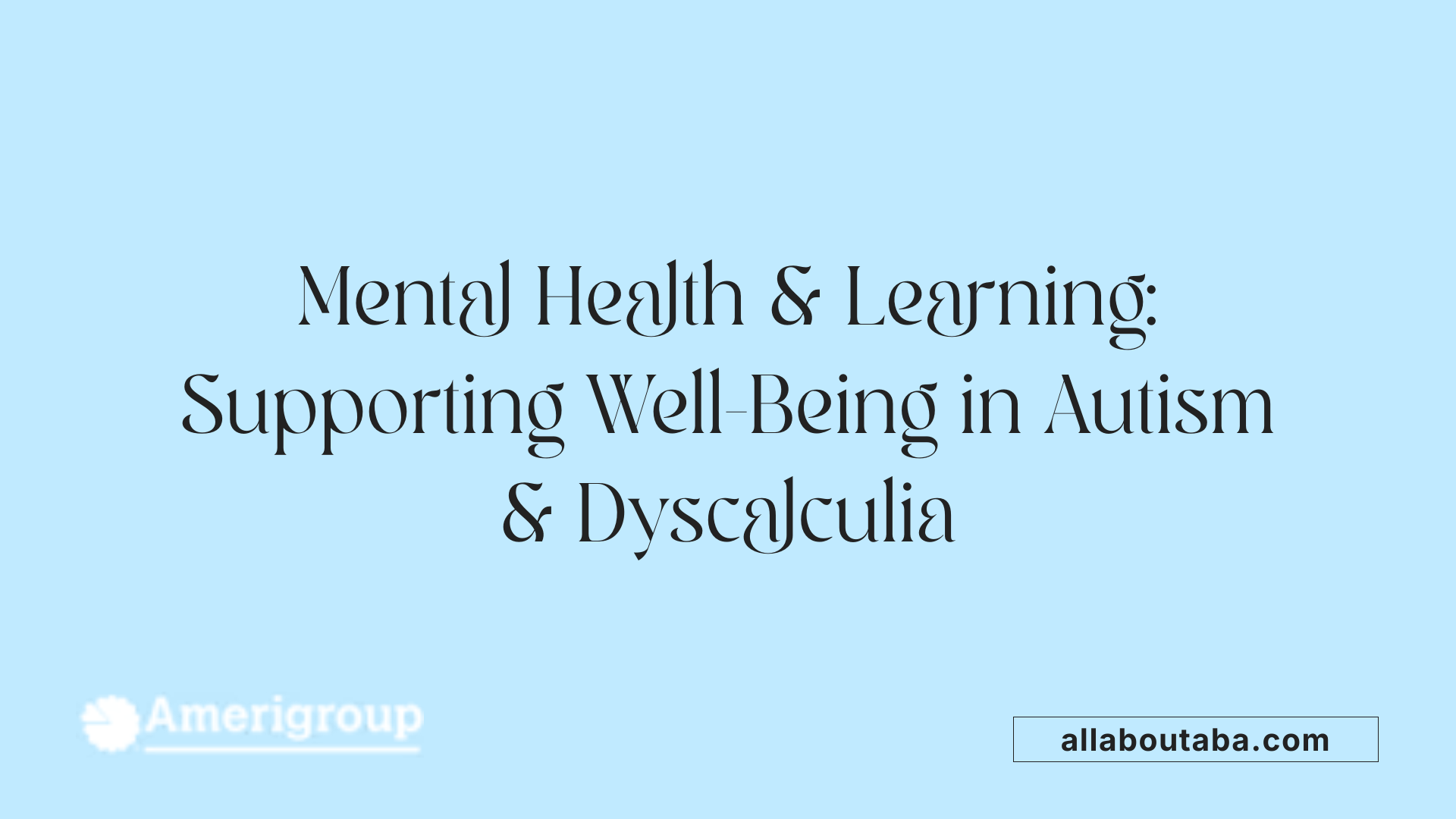
What mental health challenges are associated with autism and dyscalculia?
Individuals with autism spectrum disorder (ASD) and dyscalculia face an increased risk of mental health challenges such as anxiety and depression. These risks are heightened when both conditions co-occur, leading to compounded emotional and cognitive difficulties. Anxiety notably affects math performance, with test anxiety being particularly prevalent and disruptive among autistic individuals.
Increased anxiety and test anxiety
Test anxiety can negatively impact mathematical problem-solving abilities. Autistic people are more prone to heightened levels of anxiety disorders, and this elevated test anxiety can reduce their confidence and performance on math tasks. This anxiety not only impairs cognitive focus but also reinforces a negative cycle of stress and academic difficulty.
Effects on self-esteem
Struggles with math and related executive functions may contribute to frustration and lowered self-esteem in individuals experiencing both ASD and dyscalculia. These feelings can exacerbate anxiety and avoidance behaviors, making it harder to engage with educational challenges or social situations involving numerical tasks.
Importance of tailored mental health supports
Effective management of mental health requires individualized support strategies. Therapeutic interventions like cognitive behavioral therapy (CBT) and mindfulness practices have shown promise in helping autistic individuals and those with dyscalculia enhance emotional regulation, reduce anxiety, and build better coping skills. Such tailored supports not only improve mental well-being but can also have positive impacts on academic and daily functioning.
Comprehensive support involves recognizing the unique interplay of autism and dyscalculia symptoms and addressing emotional health alongside learning needs. This holistic approach enables individuals to better manage challenges, leverage strengths, and improve quality of life and academic outcomes.
Assessment and Identification in Overlapping Conditions
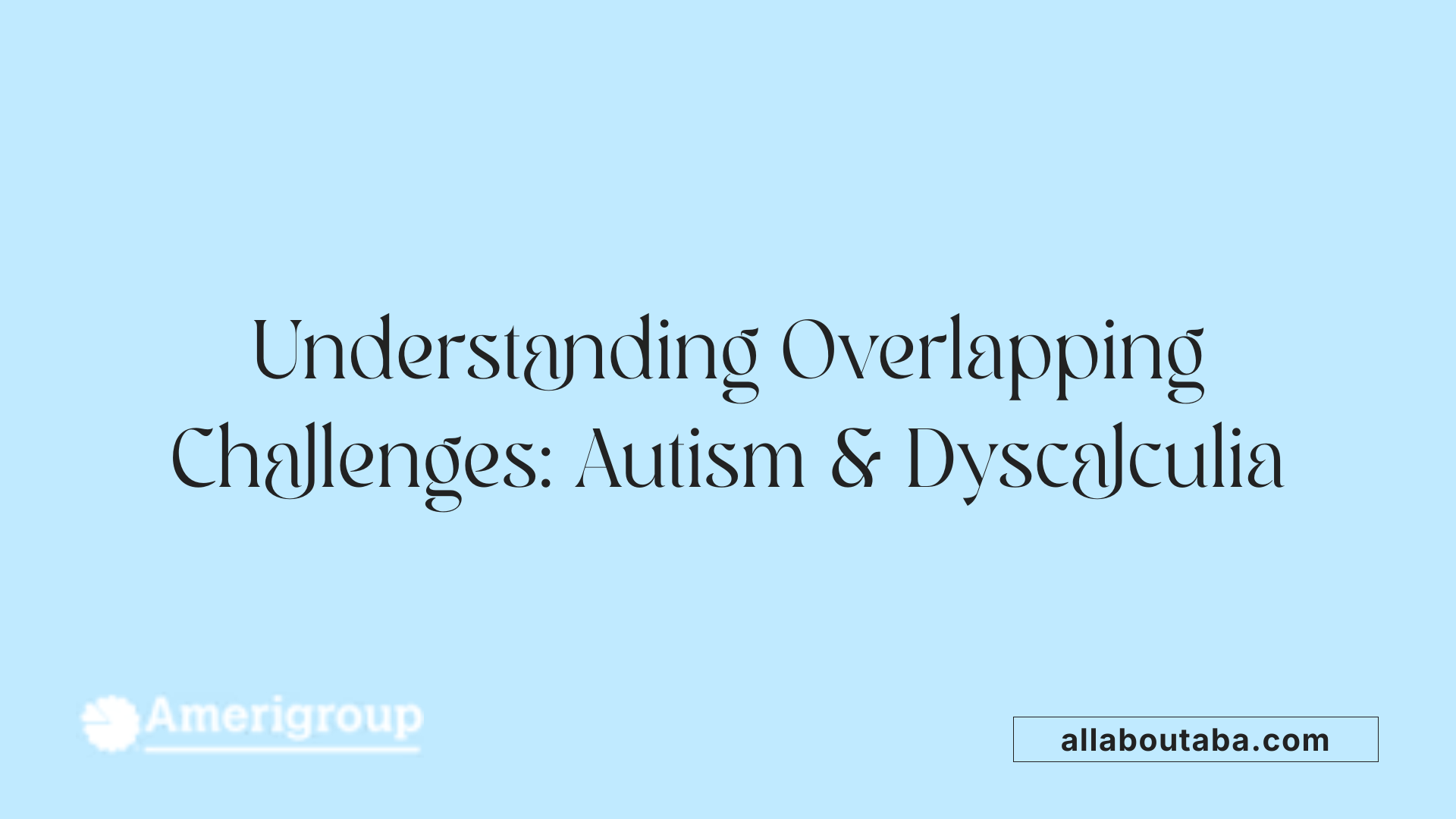
How is dyscalculia identified in children with autism?
Identifying dyscalculia in children with autism requires a comprehensive multidisciplinary evaluation. This assessment involves collaboration between educational psychologists, occupational therapists, speech therapists, and teachers. Each professional contributes unique expertise to capture the child's cognitive, sensory, and educational profile.
Considering cognitive and sensory factors
Autism and dyscalculia share overlapping challenges such as difficulties with executive functioning, working memory, attention, and sensory processing. These shared traits make assessment complex. Evaluations must consider the interactions of all co-occurring conditions, ensuring that difficulties related to sensory sensitivities or attention deficits are distinguished from pure mathematical learning challenges.
Importance for individualized support
A thorough and nuanced assessment is crucial for accurate diagnosis and tailoring support strategies. Understanding how autism influences math learning through sensory processing and executive function impacts allows for the design of effective, individualized interventions. These may include structured, multisensory instruction and environmental accommodations leveraging the child's strengths to improve math skills and daily functioning.
| Aspect | Description | Role in Assessment |
|---|---|---|
| Multidisciplinary Evaluation | Team approach including psychologists, therapists, and educators | Provides broad, detailed understanding |
| Cognitive and Sensory Factors | Attention, working memory, sensory processing challenges | Differentiates types and sources of difficulty |
| Individualized Support | Tailored learning plans using assessment findings | Enables targeted interventions and accommodations |
Long-Term Outcomes and the Importance of Supportive Resources
What are the long-term implications of autism and dyscalculia, and how can supports help?
Mathematics skills, particularly applied problem solving, play a vital role in educational and vocational success during adulthood. For individuals with autism spectrum disorder (ASD) and co-occurring dyscalculia, challenges in math can create significant barriers to achieving these life milestones. However, early intervention and ongoing targeted support can significantly improve long-term outcomes.
Supportive therapies such as applied behavior analysis (ABA) and cognitive behavioral therapy (CBT) help develop executive functioning and emotional regulation. These therapies can reduce anxiety, boost self-esteem, and improve problem-solving abilities. Moreover, recognizing and leveraging individual strengths—including special interests, strong verbal abilities, or visual-spatial reasoning—enables a more tailored approach that enhances learning and confidence.
Professional and social support play a crucial role. Multidisciplinary assessments involving educational psychologists, occupational therapists, and speech therapists help craft personalized strategies and accommodation plans. Collaboration between families, educators, and healthcare providers ensures consistent support across environments. Organizations and charities also provide valuable resources to facilitate access to care and promote social inclusion.
Ultimately, combining therapeutic interventions, strength-based approaches, and coordinated support favors independence and positive life trajectories for those navigating both autism and dyscalculia.
Bridging Challenges Through Understanding and Support
The intersection of autism and dyscalculia presents multifaceted challenges in learning, cognition, and mental health. Recognizing their connection underscores the need for early, comprehensive assessment and tailored intervention strategies that address cognitive, sensory, and emotional aspects. With informed therapies and coordinated support from professionals, families, and educators, individuals can develop the skills and confidence necessary to navigate academic and life demands, thereby improving overall well-being and success.







